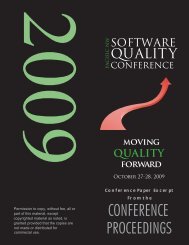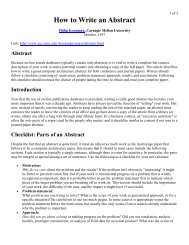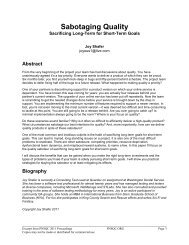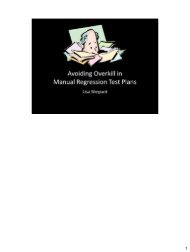Permission to copy, without fee, all or part of this material ... - PNSQC
Permission to copy, without fee, all or part of this material ... - PNSQC
Permission to copy, without fee, all or part of this material ... - PNSQC
Create successful ePaper yourself
Turn your PDF publications into a flip-book with our unique Google optimized e-Paper software.
and ask each person <strong>to</strong> choose the best pro<strong>to</strong>type. Now imagine the results are: Pro<strong>to</strong>type A is best<br />
acc<strong>or</strong>ding <strong>to</strong> 4 people, pro<strong>to</strong>type D is ranked best by 3 people, pro<strong>to</strong>type C is chosen by 2 people, and<br />
pro<strong>to</strong>type B is selected best by 1 person. Theref<strong>or</strong>e, you select pro<strong>to</strong>type A f<strong>or</strong> further development.<br />
There are several problems with <strong>this</strong> approach. Suppose that while your ten evalua<strong>to</strong>rs are looking at the<br />
four pro<strong>to</strong>types, they are ment<strong>all</strong>y ranking each alternative in <strong>this</strong> way:<br />
A > B > C > D acc<strong>or</strong>ding <strong>to</strong> 4 people<br />
D > C > B > A acc<strong>or</strong>ding <strong>to</strong> 3 people<br />
C > B > D > A acc<strong>or</strong>ding <strong>to</strong> 2 people<br />
B > C > D > A acc<strong>or</strong>ding <strong>to</strong> 1 person<br />
Notice that even though pro<strong>to</strong>type A is selected as best by the pure plurality rule, that pro<strong>to</strong>type is<br />
evaluated as the w<strong>or</strong>st design by 60% <strong>of</strong> your evaluation group. Furtherm<strong>or</strong>e, in <strong>this</strong> situation, suppose<br />
that pro<strong>to</strong>type A was compared against each <strong>of</strong> the other pro<strong>to</strong>types in a head-<strong>to</strong>-head fashion. Pro<strong>to</strong>type<br />
A would lose each head-<strong>to</strong>-head comparison by a 60% <strong>to</strong> 40% margin. Addition<strong>all</strong>y, in some sense the<br />
non-winning opinions do not contribute directly <strong>to</strong> the final result.<br />
== The Maj<strong>or</strong>ity Run<strong>of</strong>f Technique<br />
The problems with pure plurality led <strong>to</strong> the development <strong>of</strong> another group selection technique which is<br />
usu<strong>all</strong>y c<strong>all</strong>ed the maj<strong>or</strong>ity run<strong>of</strong>f system. There are many possible variations on the idea, but the winning<br />
alternative is required <strong>to</strong> receive m<strong>or</strong>e than 50% <strong>of</strong> the first place votes <strong>of</strong> <strong>all</strong> votes cast. This can be<br />
accomplished either by perf<strong>or</strong>ming multiple rounds <strong>of</strong> voting, <strong>or</strong> by perf<strong>or</strong>ming just a single round <strong>of</strong> voting<br />
but requiring the evalua<strong>to</strong>rs <strong>to</strong> rank <strong>all</strong> options from best <strong>to</strong> w<strong>or</strong>st. F<strong>or</strong> example, if evalua<strong>to</strong>rs vote f<strong>or</strong> the<br />
best pro<strong>to</strong>type design acc<strong>or</strong>ding <strong>to</strong> the data above, after the first round <strong>of</strong> voting, no pro<strong>to</strong>type would have<br />
a maj<strong>or</strong>ity. So, the list <strong>of</strong> candidates would be reduced (typic<strong>all</strong>y <strong>to</strong> the <strong>to</strong>p two options.) In <strong>this</strong> case the<br />
<strong>to</strong>p two alternatives are pro<strong>to</strong>type A with 4 votes and pro<strong>to</strong>type D with 3 votes. A second round <strong>of</strong> voting<br />
takes place. If evalua<strong>to</strong>rs vote acc<strong>or</strong>ding <strong>to</strong> their <strong>or</strong>iginal ranking preferences above, after the second<br />
round <strong>of</strong> voting, pro<strong>to</strong>type A would still receive 4 votes as best but pro<strong>to</strong>type D would now receive 6 votes<br />
and be declared the winner. Using multiple rounds <strong>of</strong> voting in a s<strong>of</strong>tware development and quality<br />
environment <strong>of</strong>ten has significant disadvantages compared <strong>to</strong> using a single round <strong>of</strong> voting. In some<br />
s<strong>of</strong>tware development scenarios, multiple rounds <strong>of</strong> voting simply aren't feasible. Furtherm<strong>or</strong>e, because<br />
you are dealing with human beings, multiple rounds <strong>of</strong> voting can become tedious. Also, situations can<br />
arise where a group <strong>of</strong> people are voting f<strong>or</strong> losing alternatives over and over until they are f<strong>or</strong>ced <strong>to</strong><br />
choose an option they don't re<strong>all</strong>y like. Because voters are most <strong>of</strong>ten stakeholders in the sense that they<br />
will be affected by the outcome <strong>of</strong> the voting, you can potenti<strong>all</strong>y create disenfranchised voters at the end<br />
<strong>of</strong> a physical run<strong>of</strong>f scheme. So instead <strong>of</strong> perf<strong>or</strong>ming multiple actual rounds <strong>of</strong> voting, you can just<br />
perf<strong>or</strong>m one round <strong>of</strong> voting but require evalua<strong>to</strong>rs <strong>to</strong> rank <strong>all</strong> candidates from best <strong>to</strong> w<strong>or</strong>st. This <strong>all</strong>ows<br />
you <strong>to</strong> determine voters' preferences in virtual rounds <strong>of</strong> voting. Requiring ranking <strong>of</strong> <strong>all</strong> alternatives has<br />
disadvantages <strong>to</strong>o. The technique <strong>of</strong>ten isn't practical when the number <strong>of</strong> alternatives is large (typic<strong>all</strong>y<br />
m<strong>or</strong>e than eight) simply because humans have difficulty comparing large numbers <strong>of</strong> alternatives. Also,<br />
research has shown that evalua<strong>to</strong>rs tend <strong>to</strong> get careless with their evaluations <strong>of</strong> options that are low on<br />
their list <strong>of</strong> preferences. And, when perf<strong>or</strong>ming multiple, physical rounds <strong>of</strong> voting, evalua<strong>to</strong>rs may not<br />
rank a subset <strong>of</strong> alternatives in the same <strong>or</strong>der in which they rank the entire set <strong>of</strong> alternatives.<br />
== The B<strong>or</strong>da Count System<br />
The problems with the pure plurality and maj<strong>or</strong>ity run<strong>of</strong>f techniques led <strong>to</strong> the development <strong>of</strong> an analysis<br />
technique c<strong>all</strong>ed the B<strong>or</strong>da count system. The B<strong>or</strong>da count approach is very simple and one that you<br />
have almost certainly used bef<strong>or</strong>e. Suppose there are k alternatives. Each evalua<strong>to</strong>r ranks the<br />
alternatives from best <strong>to</strong> w<strong>or</strong>st. A <strong>to</strong>p-ranked alternative is assigned a value <strong>of</strong> k-1 points, a secondranked<br />
alternative is assigned k-2 points, and so on, down <strong>to</strong> the last ranked alternative which receives 0<br />
points. The B<strong>or</strong>da count is the sum <strong>of</strong> the point values f<strong>or</strong> each alternative. F<strong>or</strong> example, suppose there<br />
are four alternatives, A, B, C, and D, and seven evalua<strong>to</strong>rs. Theref<strong>or</strong>e a first place ranking is w<strong>or</strong>th 3<br />
points, second place is w<strong>or</strong>th 2, third place is w<strong>or</strong>th 1, and last place is w<strong>or</strong>th 0 points. If voting results<br />
are:<br />
Excerpt from 2008 Proceedings<br />
<strong>PNSQC</strong>.ORG<br />
Page 3 <strong>of</strong> 8












